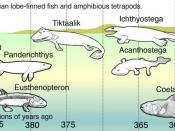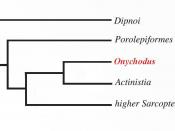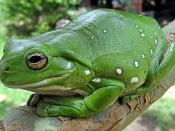Notes
Frogs, toads, salamanders, and newts are direct descendants from fish. Amphibians evolved from a type of lobe-finned fish. The name amphibian is from the Greek amphi, which means "double," and bios, which means "life." The name is appropriate because of the fact that they can live in water, as well as on land. Fossil evidence indicates that amphibians evolved from lobe-finned fishes about 370 million years ago. Recent analysis of the DNA of coelacanths and lungfishes indicates lungfishes are in fact far more closely related to amphibians than are coelacanths.
Amphibians first became common during the Carboniferous period. Biologist marked this time as the age of amphibians. By the late Carboniferous, much of North America was covered by low-lying tropical swamplands. Thirty-four families of amphibians thrived in this wet terrestrial environment, sharing it with pelycosaurs and other early reptiles. In the Permian period, after the Carboniferous, amphibians increased to a total of 40 families.
During the early Permian period a remarkable change occurred among amphibians, many of them began to leave the marshes for dry uplands. Some of these amphibians had bony plates and armor covering their bodies, and some were as big as a pony. By the mid-Permian, 60 percent of all amphibian species were completely terrestrial.
During the Tertiary period these remaining moist-skinned amphibians underwent a highly successful invasion of wet habitats all over the world. Today there are over 4,200 species of amphibians in 37 different families. Even though each amphibian order evolved at a different time during the Tertiary period, all modern amphibians have certain key characteristics in common. Legs, lungs, cutaneous respiration, pulmonary veins, and a partially divided heart have helped them to adapt, and is what they all have in common.
There are 3,680 species of frogs and toads in 22...


